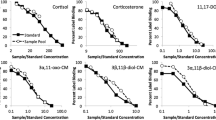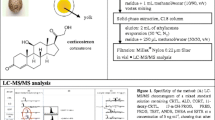Abstract
Japanese Quail (Coturnix japonica) are a common avian laboratory model, and measuring corticosterone metabolites (CM) non-invasively from Quail droppings would be of broad interest. Using the enzyme immunoassay suitable for measuring CM in droppings of Chicken (Gallus domesticus) and other galliform species, we tested the CM measured in Quail droppings after stimulation with adrenocorticotropic hormone. An ACTH challenge indicated that the assay did not detect major amounts of CM in Japanese Quail excreta. Therefore, we aimed at testing whether steroid metabolism and clearance differed between closely related species. We compared the CM excretion patterns in male and female Japanese Quail and Chicken. After intravenous injection with [3H]-labelled corticosterone, we collected all droppings for 24 h, including caecum excreta. Males and females of both species excreted radioactive CM with two peaks. The first radioactivity-peak presumably was from uric acid (Quail 45/55 min; Chicken 120/75 min post-injection, males/females respectively), whereas the second peak probably represented faecal excretion (180/210 min; 240/140 min, respectively). Several highly polar radioactive CM, but no corticosterone, was separated by chromatography in droppings of both species. Number and identity of CM considerably differed between males and females, as well as between urine and faecal excretion. The nature of excreted CM in Quail droppings remains unresolved. However, we show that knowing the effective time for dropping collection is essential for interpreting stimulus-specific CM responses, and mixing samples from rapid urine and slower faecal excretion should be avoided.
Zusammenfassung
Unterschiedliche Ausscheidungsmetaboliten von Kortikosteron bei zwei Galliformen-Arten, Japanwachteln und Hühner
Japanwachteln (Coturnix japonica) sind beliebte Laborvögel und die Möglichkeit, Kortikosteron-Metaboliten (CM) nicht-invasiv aus Wachtellosung zu messen, ist von großem Interesse. Wir haben die Messung von CM in der Losung von Japanwachteln unter Anwendung jenes Enzymimmunoassays, der für Haushühner (Gallus domesticus) und andere Galliformen-Arten geeignet ist, getestet. Ein Test mit dem Auslöserhormon Adrenocorticotropin deutete darauf hin, dass der Assay im Kot von Japanwachteln keine der hauptsächlich ausgeschiedenen Metaboliten misst. Um zu untersuchen, ob die Metabolisierung und Ausscheidung von Kortikosteron bei nahe verwandten Arten ähnlich ist, wurden die CM-Ausscheidungsmuster von männlichen und weiblichen Japanwachteln und Hühnern verglichen. Nach intravenöser Injektion von [3H]-markiertem Kortikosteron wurde 24 h lang jede abgegebene Losung inklusive Blinddarm-Ausscheidungen gesammelt. Männchen und Weibchen beider Arten schieden radioaktive CM in Form von zwei Ausscheidungs-Peaks aus. Für den ersten Peak war vermutlich der Ausscheidungsweg über Harnsäure verantwortlich (Japanwachteln 45/55 min; Hühner 120/75 min post injectionem, Männchen/Weibchen respektive), während der zweite Peak die Ausscheidung von CM über Kot darstellte (180/210 min; 240/140 min). Chromatographisch konnten wir mehrere hochpolare radioaktive CM aber kein Kortikosteron auftrennen. Anzahl und Identität der ausgeschiedenen CM unterschied sich zwischen Männchen und Weibchen, sowie zwischen Harnsäure- und Kot-Ausscheidung. Die Identität der von Japanwachteln hauptsächlich ausgeschiedenen CM bleibt offen. Wir zeigen jedoch, dass das Vermischen von Proben, die CM aus dem schnelleren Harnsäure-Exkretionsweg und/oder CM aus langsamerer Kotausscheidung beinhalten, vermieden werden sollte. Um reizspezifische CM-Veränderungen sinnvoll interpretieren zu können, ist es deshalb wesentlich, die effektive Zeitspanne für das Sammeln von Losungsmaterial zu berücksichtigen.



Similar content being viewed by others
References
Arlettaz R, Patthey P, Baltic M, Leu T, Schaub M, Palme R, Jenni-Eiermann S (2007) Spreading free-riding snow sports represent a novel serious threat for wildlife. Proc R Soc Lond B 274:1219–1224
Baltic M, Jenni-Eiermann S, Arlettaz R, Palme R (2005) A non-invasive technique to evaluate human- generated stress in the black grouse. Ann NY Acad Sci 1046:1–15
Dehnhard M, Schreer A, Krone O, Jewgenow K, Krause M, Grossmann R (2003) Measurement of plasma corticosterone and fecal glucocorticoid metabolites in the chicken (Gallus domesticus), the great cormorant (Phalacrocarax carbo), and the goshawk (Accipiter gentiles). G. Gen Comp Endocrinol 131:345–352
Dittami JP (1981) Seasonal changes in the behavior and plasma titers of various hormones in barheaded geese, Anser indicus. Can J Zool 61:2695–2697
Florkin M, Stotz EH (1963) Comprehensive biochemistry: sterols, bile acids and steroids, vol 10. Elsevier, Amsterdam
Fraisse F, Cockrem JF (2006) Corticosterone and fear behaviour in white and brown caged laying hens. Br Poult Sci 47:110–119
Goymann W (2005) On the importance of biological validations: lessons from stonechats and spotted hyenas. Ann NY Acad Sci 1046:35–53
Goymann W, Trappschuh M (2011) Seasonal and diel variation of hormone metabolites in European stonechats: on the importance of high signal-to-noise-ratios in noninvasive hormone studies. J Biol Rhythms 26:44–54
Goymann W, Möstl E, Gwinner E (2002) Corticosterone metabolites can be measured noninvasively in excreta of European stonechats (Saxicola torquata rubicola). Auk 119:1167–1173
Goymann W, Trappschuh M, Jensen W, Schwabl I (2006) Low ambient temperature increases food intake and dropping production, leading to incorrect estimates of hormone metabolite concentrations in European stonechats. Horm Behav 49:644–653
Hiebert SM, Ramenovsky M, Salvante K, Wingfield JC, Gass CL (2000) Noninvasive methods for measuring and manipulating corticosterone in hummingbirds. Gen Comp Endocrinol 120:235–247
Hirschenhauser K, Möstl E, Péczely P, Wallner B, Dittami J, Kotrschal K (2000) Seasonal relationships between plasma and fecal testosterone in response to GnRH in domestic ganders. Gen Comp Endocrinol 118:262–272
Hirschenhauser K, Kotrschal K, Möstl E (2005) Synthesis of measuring steroid metabolites in goose faeces. Ann NY Acad Sci 1040:138–153
Hirschenhauser K, Wittek M, Johnston P, Möstl E (2008) Social context rather than behavioral output or winning modulates post-conflict testosterone responses in Japanese quail (Coturnix japonica). Physiol Behav 95:457–463
Klasing KC (2005) Potential impact of nutritional strategy on non-invasive measurements of hormones in birds. Ann NY Acad Sci 1046:5–16
Kotrschal K, Dittami J, Hirschenhauser K, Möstl E, Peczely P (2000) Effects of physiological and social challenges in different seasons on faecal testosterone and corticosterone in male domestic geese (Anser domesticus). Acta Ethol 2:115–122
Lèche A, Busso JM, Navarro JL, Hansen C, Marin RH, Martella M (2011) Non-invasive monitoring of adrenocortical activity in Greater Rhea (Rhea Americana) by measuring fecal glucocorticoid metabolites. J Ornithol 152:839–847
Legagneux P, Gauthier G, Chastel O, Picard G, Bêty J (2011) Do glucocorticoids in droppings reflect baseline level in birds captured in the wild? A case study in snow geese. Gen Comp Endocrinol 172:440–445
Lexen E, El-Bahr SM, Sommerfeld-Stur I, Möstl E (2008) Monitoring the adrenocortical response to disturbances in sheep by measuring glucocorticoid metabolites in the faeces. Vet Med Austria/Wien Tierärztl Mschr 95:64–71
Möstl E, Rettenbacher S, Palme R (2005) Measurement of corticosterone metabolites in birds’ droppings: an analytical approach. Ann NY Acad Sci 1046:17–34
Nakagawa S, Möstl E, Waas JR (2003) Validation of an enzyme immunoassay to measure faecal glucocorticoid metabolites from Adélie penguins (Pygoscelis adeliae): a noninvasive tool for the measurement of stress? Polar Biol 26:491–493
Palme R, Fischer P, Schildorfer H, Ismail MN (1996) Excretion of infused 14C-steroid hormones via faeces and urine in domestic livestock. Anim Reprod Sci 43:43–63
Palme R, Möstl E, Brem G, Schellander K, Bamberg E (1997) Faecal metabolites of infused 14C-progesterone in domestic livestock. Reprod Dom Anim 32:199–206
Palme R, Rettenbacher S, Touma C, El-Bahr SM, Möstl E (2005) Stress hormones in mammals and birds: comparative aspects regarding metabolsim, excretion, and noninvasive measurement in faecal samples. Ann NY Acad Sci 1040:162–171
Rettenbacher S, Möstl E, Hackl R, Ghareeb R, Palme R (2004) Measurement of corticosterone metabolites in chicken droppings. Br Poult Sci 45:704–711
Taylor W (1971) The excretion of steroid hormone metabolites in bile and faeces. Vitam Horm 29:201–285
Thiel D, Jenni-Eiermann S, Palme R (2005) Measuring corticosterone metabolites in droppings of capercaillies (Tetrao urogallus). Ann NY Acad Sci 1046:1–13
Touma C, Sachser N, Möstl E, Palme R (2003) Effects of sex and time of day on metabolism and excretion of corticosterone in urine and faeces of mice. Gen Comp Endocrinol 130:267–278
Washburn BE, Millspaugh JJ, Schulz JH, Jones SB, Mong T (2003) Using fecal glucocorticoids for stress assessment in mourning doves. Condor 105:696–706
Wasser SK, Bevis K, King G, Hanson E (1997) Noninvasive physiological measures of disturbance in the northern spotted owl. Conserv Biol 11:1019–1022
Wasser SK, Hunt KE, Brown JL, Cooper K, Crockett CM, Bechert U, Millspaugh JJ, Larson S, Monfort SL (2000) A generalized fecal glucocorticoid assay for use in a diverse array of non-domestic mammalian and avian species. Gen Comp Endocrinol 120:260–275
Acknowledgments
We are thankful for the precious assistance by F. Schachinger during the experiments and by A. Kuchar in the laboratory, for funding by the Konrad Lorenz Research Station, the University of Vienna and the Alexander von Humboldt Stiftung. Wolfgang Goymann and two anonymous referees helped improving an earlier draft of the manuscript. The experiments meet the terms of the current Austrian laws. The experiments were conducted in Chickens and Japanese Quails with the permission of the Austrian Amt der Steiermärkischen Landesregierung (FA10A–78Hi3/2007–1).
Conflict of interest
The authors declare that they have no conflict of interest.
Author information
Authors and Affiliations
Corresponding author
Additional information
Communicated by L. Fusani.
Electronic supplementary material
Below is the link to the electronic supplementary material.
Rights and permissions
About this article
Cite this article
Hirschenhauser, K., Spreitzer, K., Lepschy, M. et al. Excreted corticosterone metabolites differ between two galliform species, Japanese Quail and Chicken, between sexes and between urine and faecal parts of droppings. J Ornithol 153, 1179–1188 (2012). https://doi.org/10.1007/s10336-012-0848-9
Received:
Revised:
Accepted:
Published:
Issue Date:
DOI: https://doi.org/10.1007/s10336-012-0848-9




